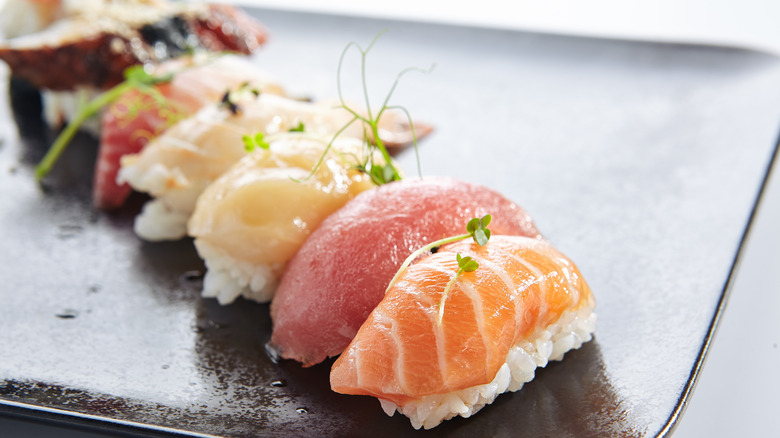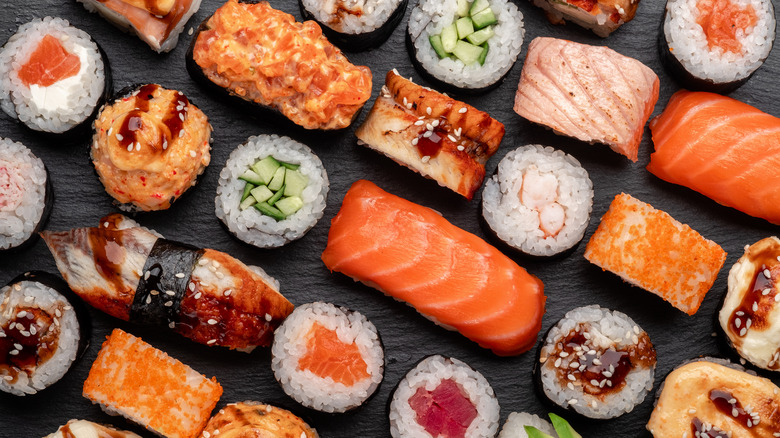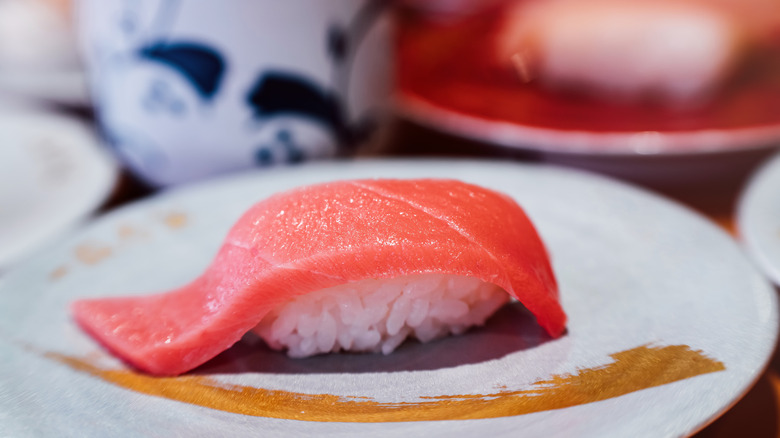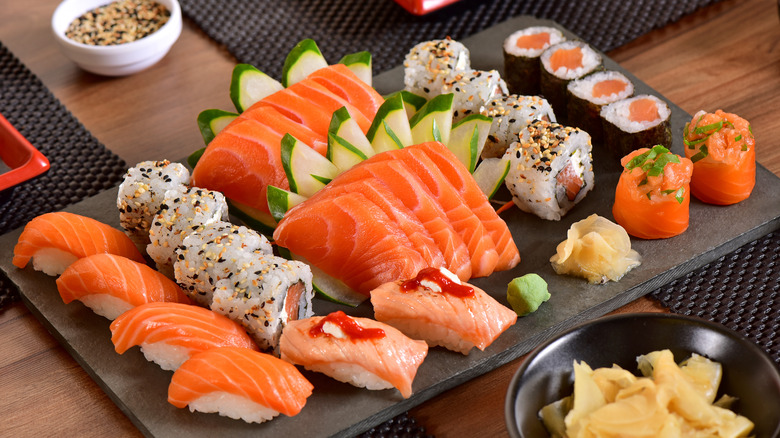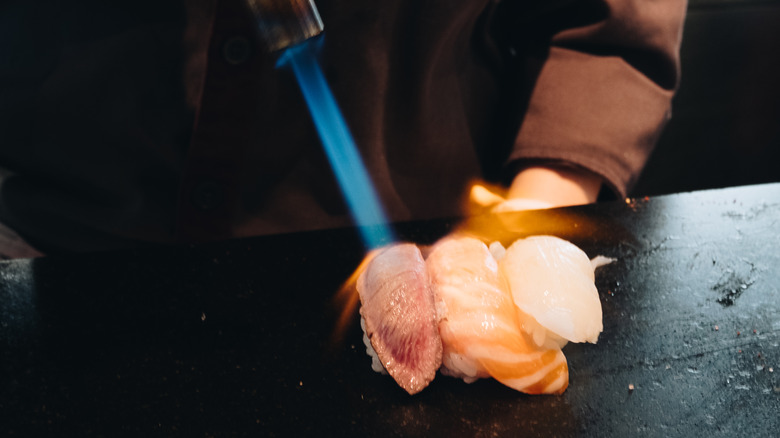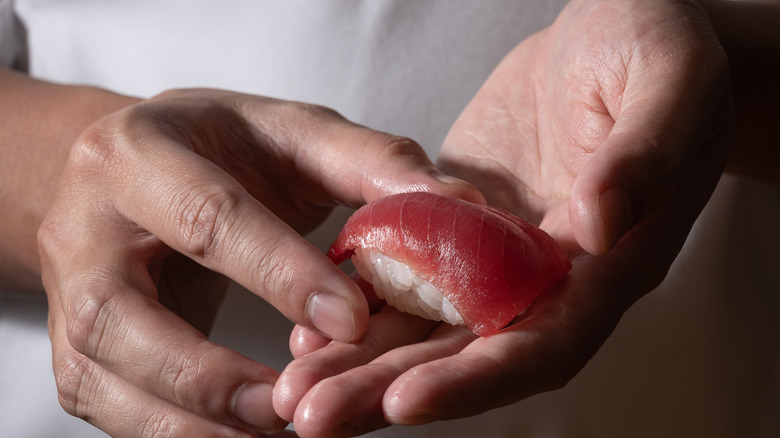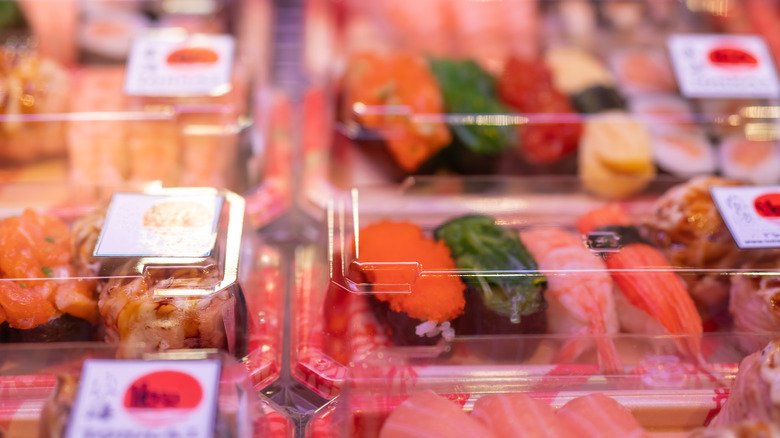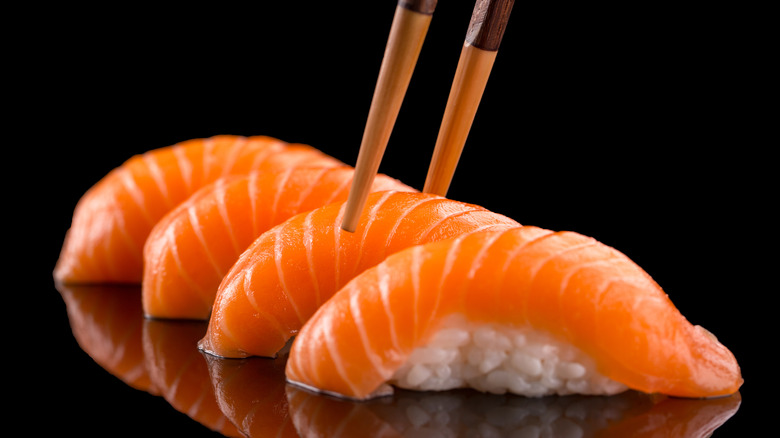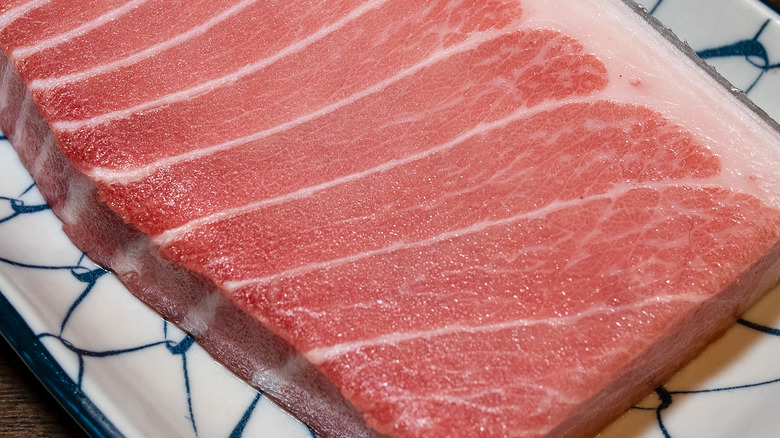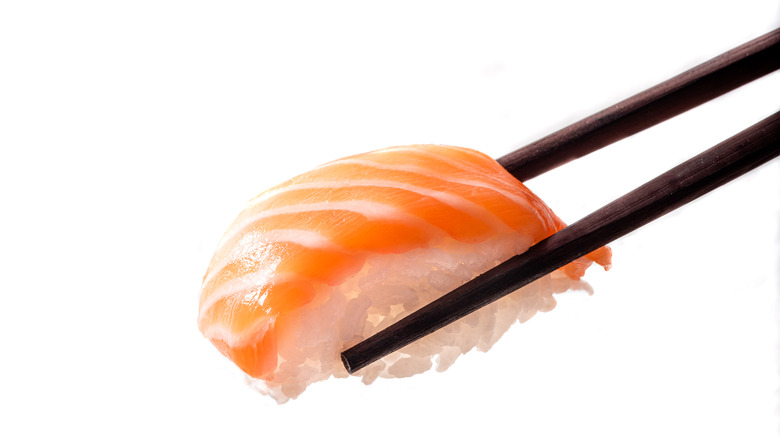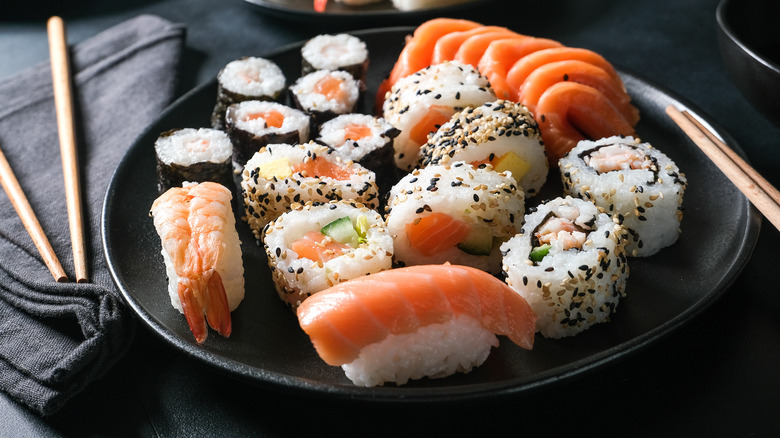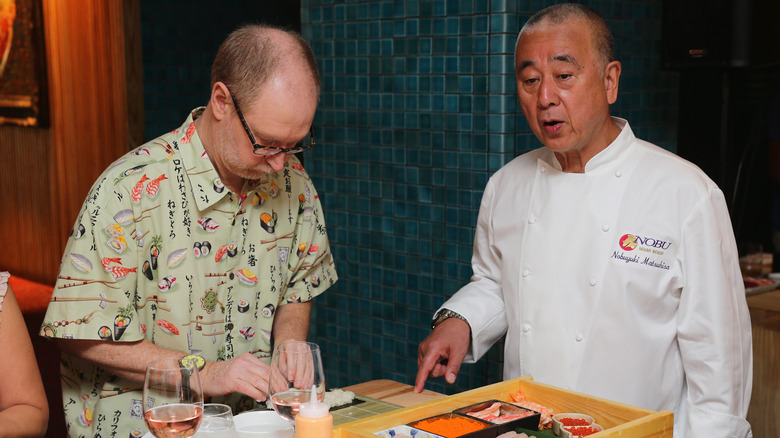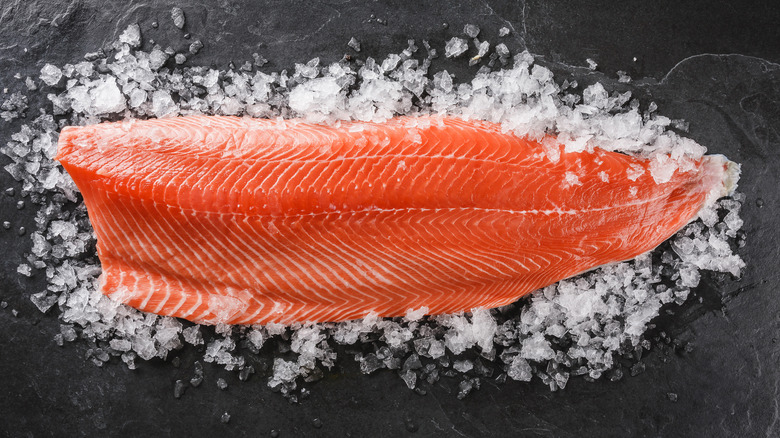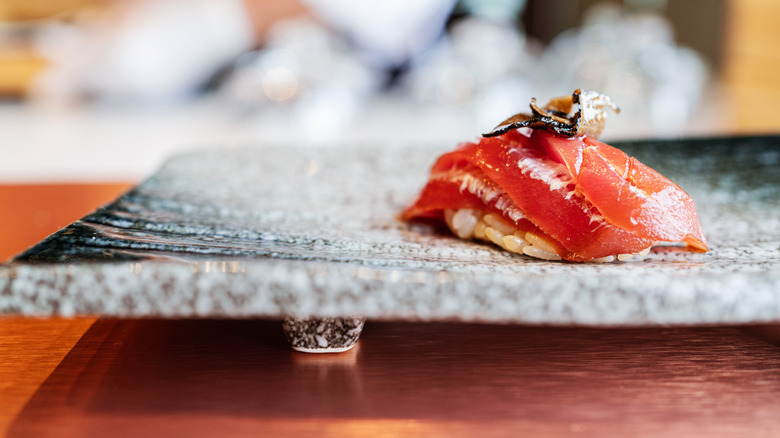The Untold Truth Of Nigiri
Compared to when the rich girl Claire pulled out a box of "rice, raw fish, and seaweed" to scorn and nose wrinkles in "The Breakfast Club," sushi has become fairly commonplace in the West, with countless restaurants peddling the Japanese specialty. But as only some menus show, there's actually a deep variety in the forms sushi can take, ranging from cut rolls to hand rolls; from simple pairings of fish and rice to more creative (and occasionally gargantuan) rolls adorned with tempura, caviar, and more.
Perhaps the most simple among them is nigiri: a slice of fish carefully positioned on a mound of seasoned rice with perhaps a dab of wasabi (via The Spruce Eats). But despite its apparent simplicity, nigiri boasts a rich history. There's a lot that probably even the most stalwart of sushi fans doesn't know about the little morsel, ranging from how it came to be to what it looks like on modern tables. So without any further ado, let's dive right in!
Nigiri has roots in Buddhist practices
There are quite a few legends linked to sushi's invention. A popular one, according to PBS, attributes it to an elderly Japanese woman who hid her pots of rice in osprey nests to keep them free from thieves, only to find that scraps of the birds' fish meals had found their way into the rice, and that it had all begun to ferment, making it tastier and extending its shelf life. Still others attribute the first sushi not to Japan at all, but rather to the Chinese, given a reference to a similar food preparation in a 4th-century dictionary. What we do know with some certainty is that sushi likely came to Japan in the 9th century as Buddhism spread in the island nation. After all, Buddhist practice calls for foregoing meat, making fish an important source of protein — and one that's fairly easily accessible in much of Japan!
But most modern sushi lovers would not have recognized this original form of sushi, known as nare-zushi or aged sushi, as being related to the largely raw preparations we enjoy today. Indeed, fermenting and aging fish was commonplace in the world of sushi for centuries. It wasn't until the 1820s that nigiri would be invented, but we can clearly see its roots beginning here.
Nigiri is a part of the category of Edomae sushi
Sushi can be broken up into several categories, of which one — Edomae — gives us a hint at the origin of nigiri in particular, according to AirKitchen. Edomae sushi hails from Tokyo, formerly known as Edo; it is also known as Kanto sushi, and it stands in contrast from the other major category, known as Kansai, or Osaka, sushi. While both forms of sushi were once aged and fermented, due to Edo's location on Tokyo Bay, sushi in that region required less manipulation than sushi made in the Osaka style. Due to Osaka being further inland, the preparation that region came to be known for doesn't just contain more sugar than the Kanto style, but is also traditionally pressed into a wooden frame box before being cut into pieces for a firmer texture and a longer shelf life.
Nigiri, which hails from Tokyo, stands out in that it often features raw (and not fermented or cured) fish, and it is made entirely by hand — as its name, which in Japanese refers to the term for a grasping motion, suggests.
Nigiri got its start as a fast food served on the streets of Tokyo
The invention of nigiri, according to PBS, is credited to a man named Hanaya Yohei, who opened the first sushi stall in Tokyo in 1824. His offerings stood out from other sushi then-popular in the region thanks to his hand-pressing technique. Thanks to the freshness of the fish — and to the popularity of his wares — he never needed to age or ferment his sushi; sushi as a fast food was born.
A century later, Tokyo was home to hundreds of sushi carts, a testament to the popularity of the invention. It would take a natural disaster — the Great Kanto Earthquake — for sushi to move indoors: Following the earthquake, low land prices meant that many sushi peddlers could finally afford replace their carts with restaurants.
While today you can find nigiri all over Japan — indeed, all over the world, thanks to its successful export beginning in the second half of the 20th century — Tokyo remains nigiri's birthplace and its capital, home to a wide range of sushi experiences, some of which Condé Nast Traveler dubs "transcendent."
Nigiri is distinct from both maki and sashimi
The category of sushi is vast, and it comprises some items unfamiliar to diners in the West, such as the pressed box sushi of Osaka (via Osaka Info). Most Tokyo-style sushi menus offer instead three major categories: sashimi, maki, and nigiri.
Sashimi is the simplest of the three: just top-quality fish, thinly sliced and served with wasabi, pickled ginger, and soy sauce. It bears mentioning that sashimi isn't technically sushi, seeing as it doesn't include any rice, according to Restaurant Clicks; the very word "sushi," after all, comes from a Japanese word that means "sour rice," according to Vocabulary.com.
Maki, meanwhile, is at the opposite end of the scale of technical complexity, featuring more ingredients and a more in-depth manipulation process than the hand-formed nigiri. Maki, according to Benihana, begins with a sheet of nori seaweed, onto which a layer of seasoned rice is arranged and gently pressed. Fish or vegetables are placed on top of the rice, and the entire thing is rolled and sliced into bite-sized pieces.
There are all kinds of maki, ranging from the ultra simple to the ultra complex. While some maki boasts just one filling, like fish or avocado, still others can border on the gargantuan, featuring tempura, roe, avocado, and more. Maki can also be served uncut, in the form of a hand roll or temaki (via Hungry Huy), or assembled inside-out, with an outer layer of rice instead of nori (via YouTube).
Nigiri can be simple or complex
Like maki, nigiri can be quite plain, but it can also be quite involved. In its simplest form, nigiri calls for a piece of fish to be placed atop a hand-molded mound of rice, according to The Spruce Eats — thus its name, which translates to "hand-pressed sushi." The chef may place wasabi on the rice before adding the fish, or they may top the fish with a garnish like fresh scallions or roe. In some cases, according to Restaurant Clicks, a band of nori seaweed is used to secure the fish to the rice.
While often the fish on nigiri is served raw, some common exceptions include cooked shrimp or eel sushi. Some nigiri fish is marinated or smoked before being used in nigiri, according to Restaurant Clicks, and there are also chefs who use a blowtorch to cook the fish on the nigiri, in part or in whole (via YouTube). There is even nigiri that doesn't feature fish at all, such as wagyu beef nigiri or tamago nigiri, which is topped with a special Japanese omelet (via WagyuMan and Great British Chefs).
Making nigiri properly is a highly technical process
For as simple as nigiri may seem at the outset, it actually demands quite a bit of technique to get just right. Per The Spruce Eats, everything from the cutting of the fish to making the rice base requires years of training, and according to RB Sushi, the molding techniques are just as demanding, ranging from Yokotegaeshi (Side Hand Flip) to Kotegaeshi (Wrist Flip), Tategaeshi (Vertical Flip) to Hontegaeshi (Original Hand Flip).
Santa Monica's Chef Masa Shimakawa tells Los Angeles Magazine that he's sick and tired of people assuming that sushi preparation is "minimalist," noting that every step of the process, from selecting the fish to butchering it to seasoning it requires experience and precision. "We don't just slice and serve; we work for the ingredients," he tells the outlet, "It's not simple rice and fish."
It's no wonder that, according to Chef Steps, sushi chefs train for decades before mastering the series of steps that lead to a perfect mouthful of nigiri for the guest!
Nigiri is both a highbrow and a convenience food with big price variations
Sushi may have gotten its start as a quick and easy convenience food, according to PBS, but since then, it has exploded in popularity. Today, sushi in general — and nigiri in particular — is available at all price points; in Japan, you can find nigiri everywhere from convenience stores like 7-11 to Michelin-starred restaurants (via YouTube and Michelin Guide).
Of course, the quality of sushi will be vastly different depending on where you go, and so, too, will its price point. According to Sushi University, the cost of nigiri to the consumer must be calculated meticulously by the restaurateur. This calculation involves a number of factors, including the cost of the raw ingredients, the average yield of each fish species, and other overhead charges like the space and salaries for employees. The outlet notes that the hope is to operate with a cost rate — that is to say, the ratio of cost to the restaurant and price for consumers — of about 35%.
Nigiri is traditionally not eaten with chopsticks
If you're worried about your chopstick skills, you can rest easy, especially if you're ordering nigiri. Despite the pair of chopsticks you'll usually find by your plate at any Japanese restaurant, when it comes to nigiri (and, for that matter, to maki), you'll want to leave these alone: The traditional way to enjoy nigiri is not with chopsticks, but rather with your fingers.
According to The Spruce Eats, eating nigiri with your hands isn't just okay, it's actually more polite. After washing your hands thoroughly, according to SushiFAQ, your fingers are your best tools, not only for applying extra wasabi (though most pieces will be designed by the chef to be perfectly balanced and thus shouldn't need any more seasoning), but also for eating each piece.
Fingers are also the tools used to dip your nigiri in soy sauce, should you choose to do so. Sushi etiquette calls for dipping the nigiri fish-side (rather than rice-side) down, to avoid the rice absorbing too much sauce (or, worse, crumbing into it). Once you've dipped the nigiri, you're expected to eat the whole thing in one bite, though SushiFAQ concedes that in some American restaurants, nigiri is just too big for this. Just do your best!
Otoro is the most sought-after nigiri topping
Toppings for nigiri can range from all manner of raw fish and shellfish to omelets and more. But the most sought-after, according to AirKitchen, is undoubtedly otoro, aka the fatty belly of the tuna. For Umami Insider, otoro has an almost sweet flavor and a rich, melt-in-your-mouth texture. It's unsurprisingly more expensive than other parts of the tuna, like akami, which is redder and leaner, or chutoro, which is technically also part of the belly, according to SushiFAQ, and texturally is somewhere between the two.
The very best otoro hails from maguro (bluefin tuna); it's no surprise, then, that 80% of the world's bluefin tuna is used by the sushi industry (via SushiFAQ). It's so sought-after that in recent years, worldwide stocks were threatened with extinction. Happily, after years of strict quotas to help protect the species, stocks are currently on the rise, according to the BBC. The Japan News reports that thanks to efforts around the world, fishing quotas are increasing this year, which is contributing to slightly lower prices. The $197,604 fetched for a giant bluefin at Tokyo's 2022 New Year's auction actually reflected the third consecutive year of price drops, according to The Straits Times!
Salmon nigiri isn't traditional in Japan
Some sushi offerings one frequently finds on Western menus are unsurprisingly not Japanese, including things like the California roll (via Insider) or the spicy tuna roll. But there's another simple stalwart many are surprised to learn is not a traditional Japanese offering: salmon nigiri.
Also known as sake nigiri per Taste Atlas, salmon sushi arrived in Japan by way of Norway, according to Norway Exports, when overfishing and the redefining of certain fishing zones led to seafood shortages in Japan. It was in 1985 that Norwegian fisheries minister Thor Listau established an initiative known as Project Japan, with the goal of promoting Norwegian seafood in the island nation. And while up until this point the Japanese eschewed salmon sushi due to their fears of parasitic worms in the fish, after 15 years of trying, in 1995 Project Japan bore fruit, and salmon sushi began to take root (via Sushi FAQ). Today, as a precautionary measure, according to Sushi Modern, fish like salmon are flash frozen to kill any parasites before being used to prepare sushi.
Nigiri became popular in the U.S. beginning in the '70s
Sushi is omnipresent in the U.S. today, found everywhere from gas stations to supermarkets to restaurants. But it didn't find its way here until the '60s, when, as PBS reports, Chef Noritoshi Kanai opened Kawafuku Restaurant in LA's Little Tokyo. (It bears mentioning that this restaurant was actually part of a second wave of sushi joints Stateside, as the first sparse sprinkling of spots that had opened in the early 20th century were shuttered following Japanese internment during World War II, according to The New York Times.)
Originally serving mainly Japanese businessmen, Kawafuku soon became a hit with Japanese and American clientele alike. In 1970, the first sushi restaurant outside of Little Tokyo opened (via PBS). Osho was located in Hollywood, and as such it found many celebrity patrons, which further increased the popularity of the food in LA and nationwide.
Oddly enough, given this history, you may be surprised to learn that California rolls do not hail from Los Angeles — or, indeed, from California at all. This invention, according to Atlas Obscura, is attributed to a sushi chef in Canada.
LA may still be the nigiri capital of America
While sushi has certainly become popular nationwide, it remains a particularly special part of Los Angeles's culinary landscape. For The New York Times, Los Angeles boasts creativity and talent rarely found outside of Japan. It was the jumping-off point for such celebrity sushi chefs as Nobu Matsuhisa, who began including fusion touches like citrus, herbs, and even chile, spawning a trend of such dishes as yellowtail hamachi with jalapeño and an appreciation for well-made nigiri (via Natfluence and Metro Style).
Today, Los Angeles chefs like Masa Shimakawa are redefining the American perception of sushi. In an interview with Los Angeles Magazine, Shimakawa explores the ways in which he regularly marries Japanese techniques and local produce for a culinary experience like no other. And he's not the only one. These days, there are loads of places to enjoy excellent sushi in Los Angeles, at a variety of different price points (via Eater Los Angeles).
The world's largest nigiri was made in New York City
Los Angeles may lay claim to the oldest American sushi tradition — and depending on who you ask, one of the best (per The New York Times) — but New York City boasts at least one claim to fame: Back in 2020, the city became home to the world's largest nigiri.
The nigiri, writes Untapped New York, was made by a Flatiron sushi shop called ROLLN and weighed a whopping 70 pounds. The Australian owners David Tam and Gavin Tseng told the outlet they decided to make it to celebrate their one-year anniversary. Made with sustainably-sourced salmon, the nigiri was cut into small pieces and given out for free to customers all day long.
And lest you think this is an all-too-American approach to the delicacy of Japanese cooking, giant sushi is a thing in Japan as well (via YouTube), albeit only as a challenge of this nature. As compared to Japanese nigiri, American nigiri tends to be far larger than the single-bite portion preferred in Japan (via The Seattle Times).
Fusion nigiri is ever-growing in popularity
While many people assume that sushi in general — and nigiri in particular — is all about raw fish, the reality is that sushi is all about the rice, according to Vocabulalry.com. Which is why it's possible to have nigiri topped with anything from avocado to omelet to vegan alternatives (via Green Queen).
But what's becoming particularly popular on sushi menus around the world is fusion sushi. Nobu Matsuhisa's experience in Peru led him to spearhead Peruvian fusion flavors, so that ceviche-inspired nigiri is now popular everywhere from California to Oklahoma (via Natfluence and The Oklahoman). Others take inspiration from other Asian cuisines, like the king salmon nigiri with kale, crumbled rice crackers, and cilantro sauce at Karma Asian Fusion in Burlington, Massachusetts (via Northshore Magazine), or the French fusion flavors that pave the way for concepts like foie gras nigiri at Tom Sushi in Vancouver or lobster meunière with soy butter at Umi in Atlanta (per Hidden Gems and Epicure & Culture).
